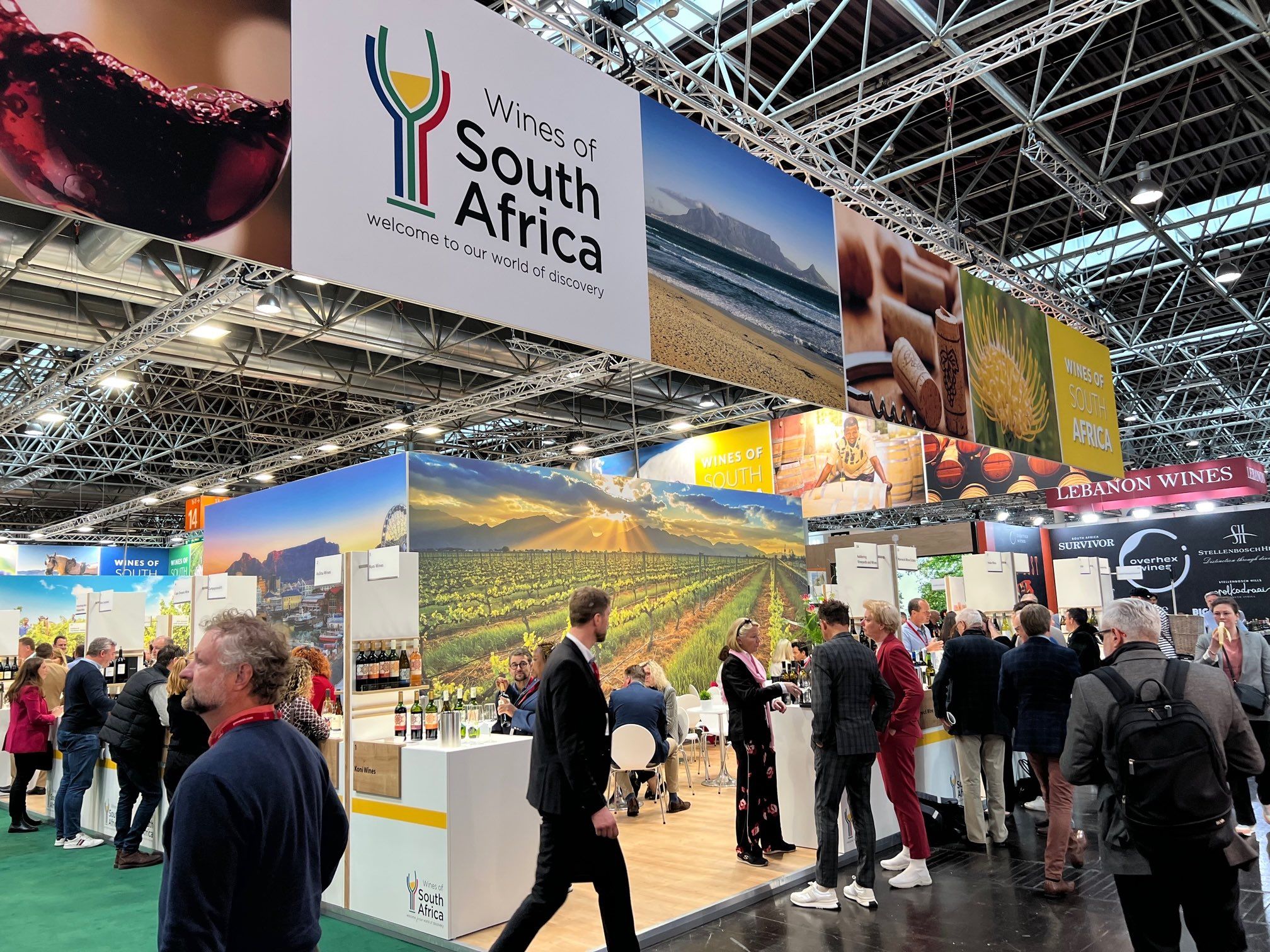You can read the first of The Buyer’s two part ProWein report here where we ask if the show still has its star power?
It felt somewhat appropriate considering their place in the world that you had to travel a long way just to visit the main New World producing countries at this year’s ProWein as they were located in the furthest away halls from the main public transport entrance.
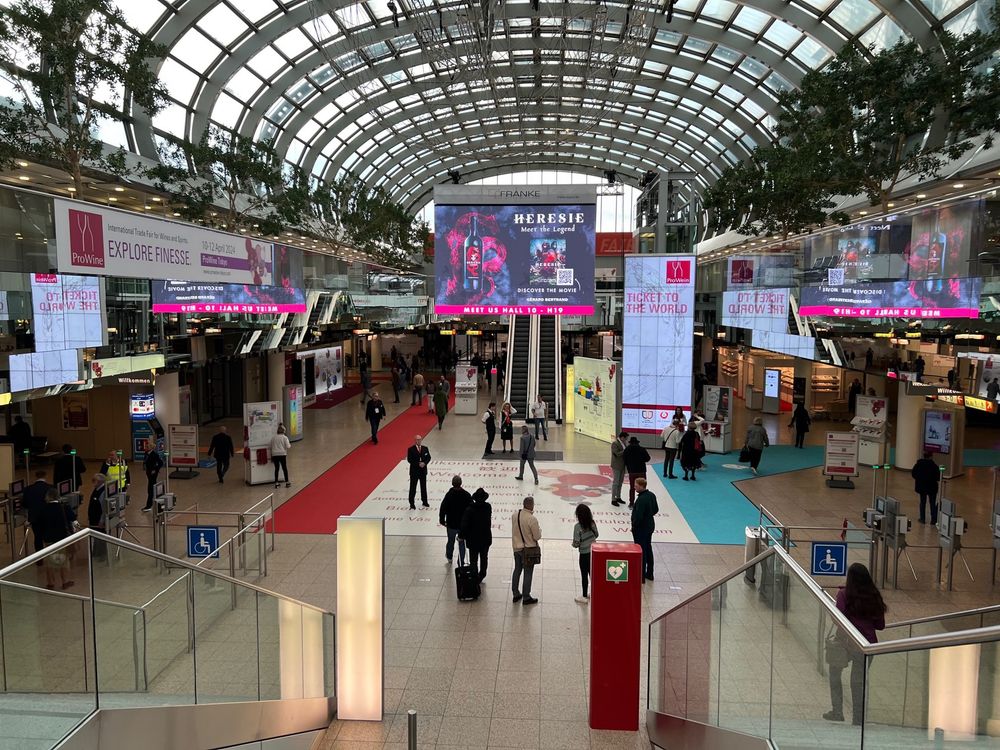
Lots of buyers attending ProWein made the New World halls their priority
But a large proportion of the 49,000 visitors who made it to ProWein last week did make the effort and they were by far the busiest and most exciting halls to be in. Particularly Hall 14 where the big contingents of producers from South Africa, Australia, New Zealand and California had made their home.
For most it was the first time they had been back to ProWein en masse as Covid lockdowns and travel restrictions had meant they were unable to attend last year’s event.
It was certainly the first time that Wines of South Africa, Wine Australia and New Zealand Winegrowers had brought their big generic stands back to the show with Australia and South Africa both reporting record numbers of producers and regional bodies keen to get back into the market and remind the world what they are all about.
There was a real energy and sense of doing business around their stands and very much a focus on promoting the countries’ premium wines and what they can do at price levels pushing £10 and over.
Back from the Cape
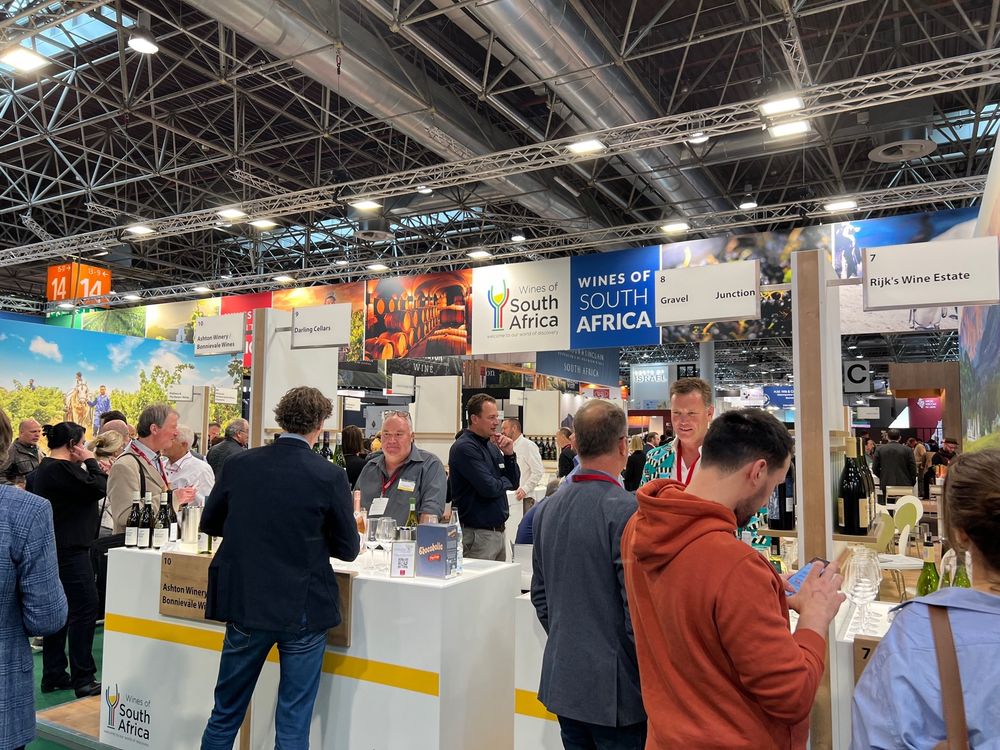
South Africa has its biggest delegation of wine producers at ProWein either on Wines of South Africa’s generic stands or on individual producer stands
South Africa had around 115 wineries represented either on Wines of South Africa stand or in their own areas compared to around 20 who made the trip last year.
Ross Sleet, managing director of Rascallion Wines who was there with its new South African partner, Wellington Wines, said it was good to see the country’s united spirt in full force. “We don’t want to beat up on our own competition, but compete against those on other stands. It’s great for the country as a whole that we are all here. It is the biggest I have seen. People are pumped and really want to do business.”
It’s also a great opportunity for Rascallion and Wellington to talk to existing and potential new markets and explain how their respective skills and offers can now offer importers and customers a wide range of bespoke, focused wines that can scale and grow. The two came together last autumn with Rascallion’s range of premium blended and single varietal wines being a good fit for Wellington, one of South Africa’s biggest producers of bulk wine.
“We are able to cement existing relationships here and demonstrate more of what we can do,” said Sleet. “It’s a big help to say we are with Wellington. It demonstrate our ambition and how we want to succeed and grow with you. We have got contracts here on the back of being with Wellington.”
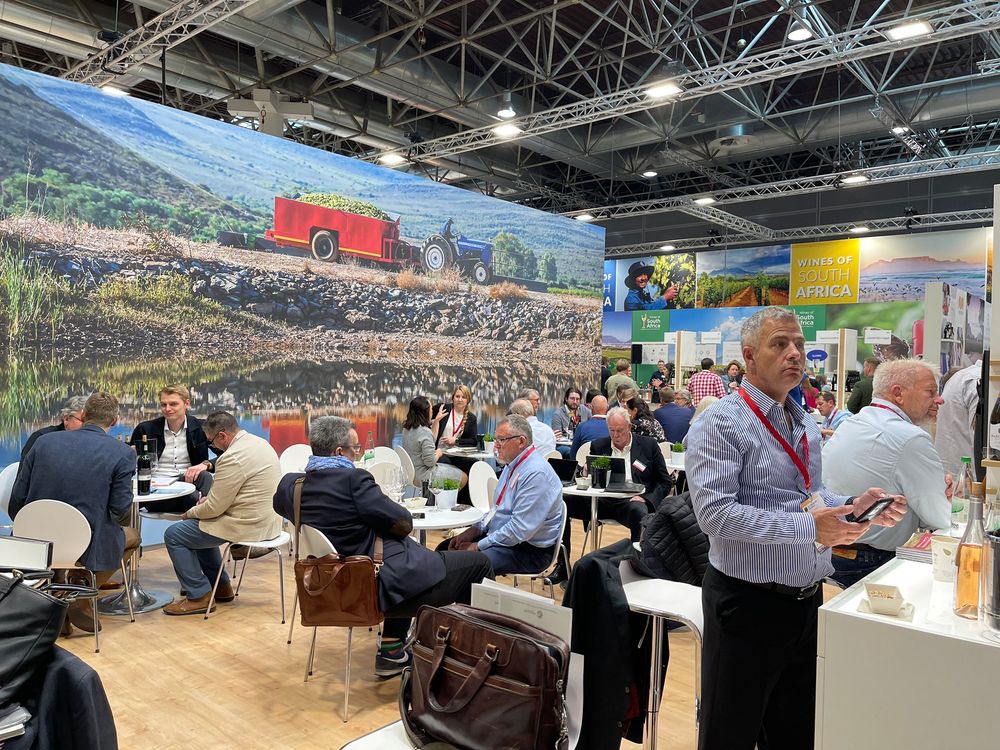
Back and doing business with key buyers and customers around the world on South Africa’s biggest stand at ProWein
It was the first time that Francois van Niekerk, chief executive of Wellington Wines, had been to ProWein and he admitted he was a bit taken aback by the scale of the show and also just how much competition South Africa has.
As a bulk producer that is usually a source for wines for many of the premium South African players at ProWein it was good to be able to show “the added value” it can now bring to its bulk wines, and the market, through the link up with Rascallion. For example, as one of the biggest handlers of old vine grapes in South Africa it can now work with them in Rascallion wines, particularly its Vinyl Collection.
“It’s a different mind set for us as traditionally we have been a production centre and not had a focus on building brands,” he added. “If you are only selling bulk it is becoming more of a challenge with all the increase in costs. We need to add value.”
ProWein was also an important step in its bid to raise its exports from 30% of the business.
Premium message
Pierre Nortje, international sales manager at Spier, one of South Africa’s fastest growing producers, said ProWein “is really the place where the whole world comes together”. “It’s the key place for meetings and where you can get to see your customers from Canada, the US, the UK to Kazakhstan. It’s great to see so many South African producers here and get back to what it was as ProWein,” he said.
The scale of the Spier business means it has different types of relationships in its key markets, be it primarily pushing it core premium brands in the UK, to working more on bespoke own label projects with customers in Europe, he added.
It was also the first major show it has been to since it teamed up with Freixenet Copestick in the UK and can benefit from all the “new traction, energy and focus” it is now getting across all channels and into the on-trade with Jascots Wine Merchants and direct to consumer with Slurp.
DGB was at Prowein to demonstrate to existing and new customers its sustainability credentials which includes a vow to bottle every wine it makes domestically in order to safeguard jobs in the Cape. This is very much part of what it calls its value and ethical chain, said Andrew Harris, DGB’s marketing director. It’s also part of its commitment to only make premium wine.

Bruce Jack had his own stand to promote the wines across Bruce Jack Wines full range
Interestingly many of the South African producers said how strong their neighbouring African countries are now as key growing markets. Bruce Jack of Bruce Jack Wines said it was fascinating to see just how the wine markets are opening up in key parts of the country, particularly in Kenya, Nigeria, Namibia and Tanzania and Rwanda. Buyers from all those markets were at ProWein looking to do business with their South African counterparts.
“They are early markets but they are all doing well and they are also looking for premium wines. There is an opportunity to get good distribution there. Particularly in areas where is good tourism.”
Jack said it was also looking far closer at what it could do in India and said the potential there is enormous if the wine market really takes off.
Bernard Fontannaz, owner of Origin Wines, said it was good to see more wines being offered from South Africa at closer to £10. That is the part of the market it needs to be in. Particularly in the UK on the back of the recent big jump in alcohol duty. “It is a good time to reposition ourselves and make it more sustainable for us all.
Sleet agreed and believes the market is “wide open” in the UK for South African brands between £8.99 and £12.99. “We know we can deliver that and need a partner in the UK that can match that ambition. If we are going to move the needle we need more wines in that price point. We need to be a relevant brand in key markets that can help us make money.”

Free pour tastings and education areas were a key part of Wines of South Africa’s stand
DGB’s wine marketing director, Andrew Harris, said it was able to host buyers and customers from all over the world on its standalone stand and that it was good to see such a “strong return” to the show from South Africa.
Its focus is 100% behind promoting premium South African wines and brands, with big names such as Bellingham, Boschendal and Franshoeck Cellar and Brampton Wines in its range. Its definition of premium is anything that sits at 150 rand and above.
DGB has even created what it calls is 360 degree fine wine wheel to demonstrate the eight key steps it is taking up and down its business to drive a premium and sustainable strategy through its value chain, said Harris. From how it works with its growers right through to how it talks to its customers and consumers
“We want to lead the premium charge in South Africa,” he added, stressing it only works with the 9% top sustainable growers in the country, increasingly in the cooler grape growing areas. “We will make sure we pay them the right price for their grapes.”
Australian push
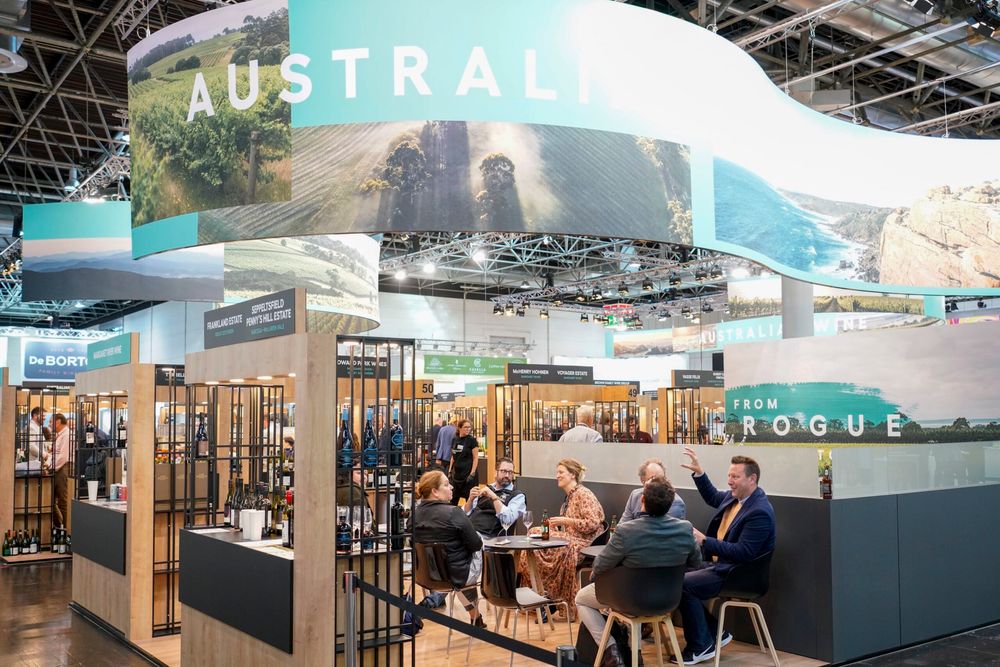
Australia was back with a bang at ProWein
Wine Australia said it had doubled its presence to make it officially its biggest show yet with 61 producers, including 147 winemakers, and six regional bodies and their members all vying for attention, representing a total 47 regions.
It was the first time Australia could really come together on this scale since Covid, said Laura Jewell MW, Wine Australia’s regional general manger for the UK, Europe and EMEA. It was clear, she added, how much Australian producers wanted to make up for lost time, and, in particular, look for new markets and consolidate existing ones on the back of the collapse in the Chinese market.
ProWein, she said, was particularly important for wineries as it gives them access to buyers across Europe, but also crucially into north America and Canada.
Jewell added she was pleased to see so much regional support this year and them backing their members and wineries with dedicated stands which certainly helps tell a bigger and wider story from Australia.
Austrade had also worked hard to bring potential importers and buyers from key markets including Poland, Czech Republic, Israel and the Netherlands and Wine Australia is looking to work closer with AusTrade going forward, she added.
It is also stepping its activity around the world and now has country managers in key strategic countries such as South Korea and Japan.
Jewell said the show had come at a good time for many producers as it comes on the back of what has been a lower than average harvest in Australia which will hopefully allow wineries to rebalance the issue of supply and demand that had seen large volumes of wine in the market last year.
As well as ProWein Jewell said she was also pleased to see the number of producers that are now “eager and keen” to get back into the UK market and build on its position there where Australia sales are bucking the national picture – down 3% versus an overall 5% market decline.
Regional push

Australia also had a number of key regional bodies at the show with their members
Riverland Wine was one of a number of regions that had teamed together to bring producers to the show. Its stand featured five producers from the Riverland Uprisingwho were all at ProWein for the first time. The genuine excitement and passion to be there and tell their respective stories – from Mallee Estate, Sixty Eight Roses, Oxford Landing, Unico Zelo and Starrs Reach – was infectious.
John Koutouzis, winemaker at Sixty Eight Roses, said it was great to be there as “a team” and tell their individual stories together and “get Riverland on the map as a region that makes experiment wines and change people’s perceptions”.
The fact the five producer are all similar in size and represent the “boutique” side of Rieverland is a first for the region. It is also why, he said, it had deliberately looked to use bold imagery and the distinctive photography of Matt Wilson So that it can “stand out” from other regions.
Jim Markeas, manager of Mallee Estate, said it has encouraged them to do more “interesting things together” and look at other trade shows in Asia like Vinexop Singapore in May or Wine Paris & Vinexpo Paris next year. “It is good to be here to tell people our story and how we are willing to take risks and work with different varieties from Spain, Italy and Greece. How we differentiate ourselves.

Wine Australia’s stand also had a full masterclass programme
Richard Dolan, managing director of Bec Hardy Wines, added: “This was my first time at ProWein and it was beyond my expectations. A must-do event and I’m in for next year.”
Philip Jeffries, general manager of sales and marketing at d’Arenberg, said: “There’s renewed energy and a new mindset to Australian wine, trade were open to explore new opportunities and more premium offerings.”
Return of the Kiwis
Chris Stroud, market manager for Europe for New Zealand Winegrowers said ProWein was a great opportunity for it to “showcase” its new brand identity ‘Altogether Unique’ and said the show was a great opportunity for producers to get back to business after four years away from the show.
He said: “It was fabulous to reconnect with our exhibitors and key visitors again as well as make new introductions and find opportunities in what is the first time in four years. All in all it was a great success and lots to build on for the future.”
The New Zealand contingent on its generic stand included 38 producers which was down on but also included a number who had taken up space to exhibit independently.
Stroud added: “We see this as a positive that New Zealand companies are confident to be independent and it created a larger New Zealand wine presence at ProWein. The New Zealand Winegrowers stand was the centrepiece to that and all New Zealand wineries were mainly located around us. We are looking to continue to grow the New Zealand attendance at Prowein.”
In terms of what buyers were looking for Stroud said it was still very much to “discover our Sauvignon Blancs but I think there is a growing understanding of the wide variety of styles that New Zealand now produces”. He added: “Prowein is a great showcase for that and there were certainly key buyers looking for a wide range to add to their portfiolio – whether it be Pinot Noir, our red blends, or other white wines. We held a themed varietal tasting each day so guests could explore the range of wines we have available.”
In terms of where it sees ProWein and it’s future Stroud said: “It is still the largest trade show and for us in the New World, it is currently the most relevant attracting key decision makers from around the world. Dusseldorf may not have the glamour of other cities that host international wine fairs, and there are a number of issues: timing is not ideal for travelling winemakers, while there are ongoing issues around cost of accommodation and this year transport strikes. However, from a business perspective it is where a lot of deals are done, important meetings conducted and is the most relevant show for our producers – currently at least.”
What next?
It will be interesting to see how much of a lure Wine Paris & Vinexpo Paris will be for the big southern hemisphere countries who have yet to really experience it. There were a number of producers intrigued to know what they are missing out on, particularly as it also offers greater flexibility in terms of accommodation, flights and the overall cost to attend.
Matthew Johnson at Beyond Wines said having such a strong New World presence was what still very much gives ProWein the edge. He explained: “I was dubious that it would be so relevant having heard how successful Wine Paris had been, however, it’s clear ProWein is more international, and Wine Paris had very limited space for anything from the New World. ProWein was extremely useful as it gave us the time to see key suppliers from the US, Australia, New Zealand and so on.”
He added: “ProWein is still very relevant and will continue to be so over the next few years, particularly for the bigger retailers looking at the New World. But it certainly looks like as a business we may need to attend both in the future.”
- You can read Richard Siddle’s first main ProWein report on The Buyer here.
